ASRock Industrial NUC BOX-1260P and 4X4 BOX-5800U Review: Alder Lake-P and Cezanne UCFF Faceoff
by Ganesh T S on August 5, 2022 8:15 AM EST- Posted in
- Systems
- AMD
- Intel
- UCFF
- Mini-PC
- ASRock Industrial
- Cezanne
- Alder Lake-P
System Performance: Multi-Tasking
One of the key drivers of advancments in computing systems is multi-tasking. On mobile devices, this is quite lightweight - cases such as background email checks while the user is playing a mobile game are quite common. Towards optimizing user experience in those types of scenarios, mobile SoC manufacturers started integrating heterogenous CPU cores - some with high performance for demanding workloads, while others were frugal in terms of both power consumption / die area and performance. This trend is now slowly making its way into the desktop PC space.
Multi-tasking in typical PC usage is much more demanding compared to phones and tablets. Desktop OSes allow users to launch and utilize a large number of demanding programs simultaneously. Responsiveness is dictated largely by the OS scheduler allowing different tasks to move to the background. Intel's Alder Lake processors work closely with the Windows 11 thread scheduler to optimize performance in these cases. Keeping these aspects in mind, the evaluation of multi-tasking performance is an interesting subject to tackle.
We have augmented our systems benchmarking suite to quantitatively analyze the multi-tasking performance of various platforms. The evaluation involves triggering a VLC transcoding task to transform 1716 3840x1714 frames encoded as a 24fps AVC video (Blender Project's 'Tears of Steel' 4K version) into a 1080p HEVC version in a loop. VLC internally uses the x265 encoder, and the settings are configured to allow the CPU usage to be saturated across all cores. The transcoding rate is monitored continuously. One complete transcoding pass is allowed to complete before starting the first multi-tasking workload - the PCMark 10 Extended bench suite. A comparative view of the PCMark 10 scores for various scenarios is presented in the graphs below. Also available for concurrent viewing are scores in the normal case where the benchmark was processed without any concurrent load, and a graph presenting the loss in performance.
| UL PCMark 10 Load Testing - Digital Content Creation Scores | |||
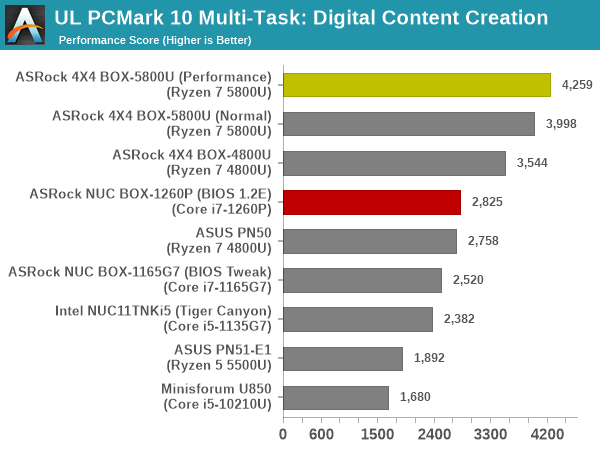
| UL PCMark 10 Load Testing - Productivity Scores | |||

| UL PCMark 10 Load Testing - Essentials Scores | |||

| UL PCMark 10 Load Testing - Gaming Scores | |||
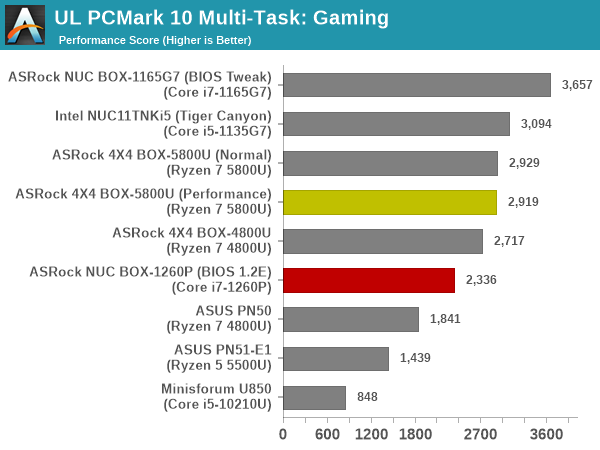
| UL PCMark 10 Load Testing - Overall Scores | |||
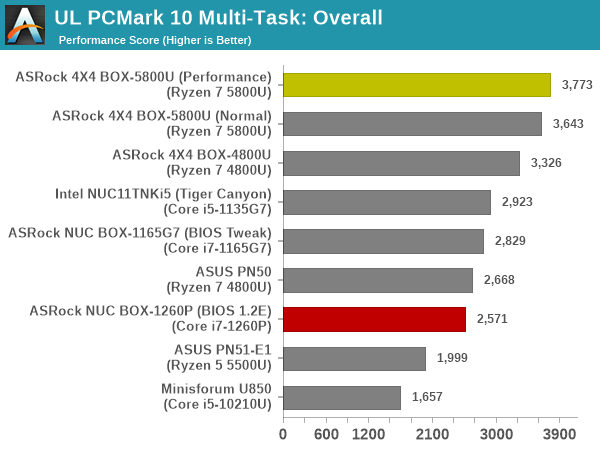
The Alder Lake system has an inauspicious beginning, falling way behind in a set of tests it is supposedly tuned for. Based on our experience with the system, it is a combination of having lesser number of performance cores compared to Cezanne, and a BIOS that has not been tuned carefully yet.
Following the completion of the PCMark 10 benchmark, a short delay is introduced prior to the processing of Principled Technologies WebXPRT4 on MS Edge. Similar to the PCMark 10 results presentation, the graph below show the scores recorded with the transcoding load active. Available for comparison are the dedicated CPU power scores and a measure of the performance loss.
| Principled Technologies WebXPRT4 Load Testing Scores (MS Edge) | |||
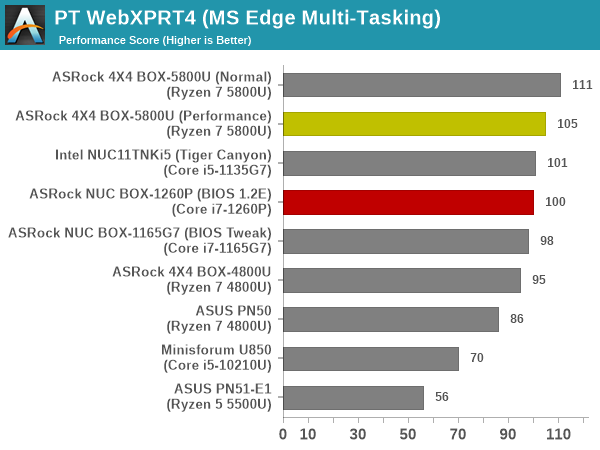
The performance of Alder Lake-P is slightly better here, but still not what we saw in other Alder Lake reviews.
The final workload tested as part of the multitasking evaluation routine is CINEBENCH R23.
| 3D Rendering - CINEBENCH R23 Load Testing - Single Thread Score | |||

| 3D Rendering - CINEBENCH R23 Load Testing - Multiple Thread Score | |||
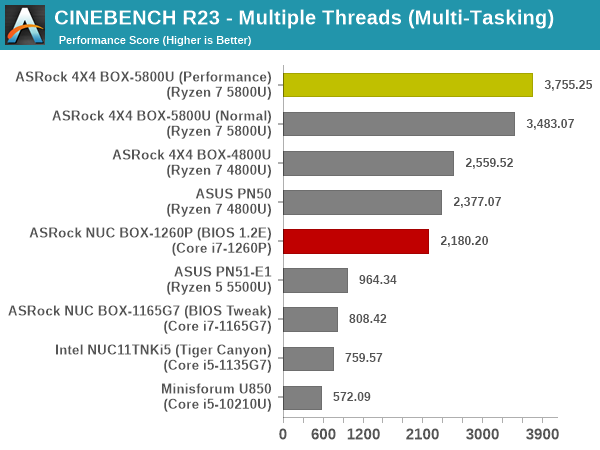
This is another dismal outing for the NUC BOX-1260P, with even the 1165G7 model having lesser performance loss.
After the completion of all the workloads, we let the transcoding routine run to completion. The monitored transcoding rate throughout the above evaluation routine (in terms of frames per second) for select systems are tabulated below.
| VLC Transcoding Rate (Multi-Tasking Test) - Frames per Second | |||||
| Enc. Pass #1 | PCMark 10 | WebXPRT4 | Cinebench | Enc. Pass #2 | |
| ASRock NUC BOX-1260P (Core i7-1260P ; BIOS 1.2E) |
1.2859 | 1.1608 | 1.1178 | 1.2515 | 1.2855 |
| ASRock 4X4 BOX-5800U (Ryzen 7 5800U ; Performance Mode) |
1.7057 | 1.5656 | 1.5053 | 1.7232 | 1.7086 |
| ASRock 4X4 BOX-5800U (Ryzen 7 5800U ; Normal Mode) |
1.6200 | 1.4950 | 1.4103 | 1.5672 | 1.6708 |
| ASRock 4X4 BOX-4800U (Ryzen 7 4800U) |
1.6366 | 1.5167 | 1.4080 | 1.5505 | 1.6073 |
| Intel NUC11TNBi5 (Akasa Newton TN) (Core i5-1135G7) |
0.8662 | 0.7773 | 0.7275 | 0.7773 | 0.8722 |
| ASRock NUC BOX-1165G7 (Core i7-1165G7) |
0.8409 | 0.8004 | 0.7230 | 0.7534 | 0.8854 |
The transcoding rates in different systems drop down with simultaneous loading, as expected. While the gap is least for the Alder Lake-P system, it comes at the cost of excessive performance loss in the concurrent workloads.










34 Comments
View All Comments
AdrianBc - Saturday, August 6, 2022 - link
Regarding the height of the case, there is no need to increase it. Intel has proved, already many years ago, that it is possible to cool without problems even a CPU with PL1 = 45 W, without increasing the volume over the classic high variant of NUC, i.e. with a volume under 0.7 L (as proven by the Skull Canyon NUC, which unfortunately did not have any successor, because Intel replaced it with much larger "NUC" computers intended for gaming).For better cooling in the same case, it would be enough to remove the possibility of installing a 2.5" HDD/SDD, while keeping the same size for the case.
The freed height could be used for a taller cooler, with enough capacity to cool even a 45 W CPU, not only a 28 W CPU.
AdrianBc - Saturday, August 6, 2022 - link
I want to add that even in the coolers of the same height the quality can vary a lot, presumably depending on price.I have a couple of the "8th generation" NUCs, and those had much better coolers than all the older NUCs that I have used, but also, from what I have heard or read, much better than the coolers of newer NUCs, which presumably have reverted to some cheaper coolers.
Those NUC8 coolers, not only are completely silent in normal use, but at maximum load on a Coffee Lake U i7 CPU with PL1 = 30 W and PL2 = 50 W, i.e. with a PL1 default value that is higher than the 28 W nominal value, there is absolutely no thermal throttling regardless how long the computer works at the maximum power consumption of 30 W and the junction temperature never exceeds 90 Celsius degrees.
So a more expensive cooler might also provide an improvement even when it is not taller.
plonk420 - Thursday, August 18, 2022 - link
3dprint one?AdrianBc - Saturday, August 6, 2022 - link
For some reason, the Thunderbolt connector has not been certified yet.Because of that, it cannot be advertised yet.
However, I have seen multiple reports that it works without problems, including in this article.
fishingbait15 - Friday, August 5, 2022 - link
So wish we could get these things running ChromeOS. I wonder if ChromeOS Flex would at least allow the Linux crosvm to run ...PeachNCream - Sunday, August 7, 2022 - link
Thinking that would be good also. What about Android x86 as an alternative? Both should still be well embedded in Alphabet's ecosystem and feature the end user monitoring, data collection, and commercialization recommendations that Google is so good at in terms of how it partners with advertisers to get you relevant, interesting ad content.You could also probably install Linux on bare metal if all you want is vanilla Linux though you aren't going to benefit from having your compute activities observed for better product placement that you would with Google distros of Linux.
iranterres - Friday, August 5, 2022 - link
Nice to see the core i6 in the benchmarks.MrCommunistGen - Friday, August 5, 2022 - link
I'd really love to see HDMI 2.1 ports on these machines since both AMD and Intel platforms should theoretically be able to support the newer standard from their iGPUs.If either supported HDMI 2.1 I'd consider using one as a multimedia box hooked up to a TV.
nandnandnand - Friday, August 5, 2022 - link
https://www.cnx-software.com/2022/01/05/intel-alde...https://www.theverge.com/2022/1/4/22855915/intel-1...
Intel only integrated HDMI 2.0b support. I guess another chip has to be added to get HDMI 2.1, like in this:
https://www.tweaktown.com/news/85259/gigabyte-brix...
Rembrandt supports HDMI 2.1, as will the iGPU in Raphael. Raptor Lake will add it according to this leaked slide:
https://www.notebookcheck.net/Intel-Raptor-Lake-S-...
So it will become more common to see HDMI 2.1 support in 2023-2024. DisplayPort 2.0 as well.
Igor_Kavinski - Saturday, August 6, 2022 - link
Excellent review, Ganesh! Really enjoyed seeing the battle between these two CPUs. Some of the wins for the Intel Alder Lake were surprising, like the iGPU and in some benchmarks like 7-zip, 5800U is a monster! Hope to see more "reviews done right" from you soon!